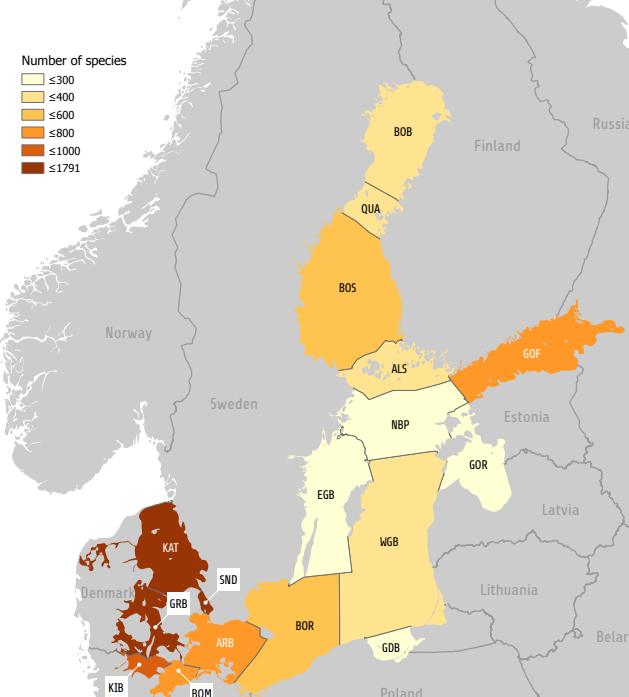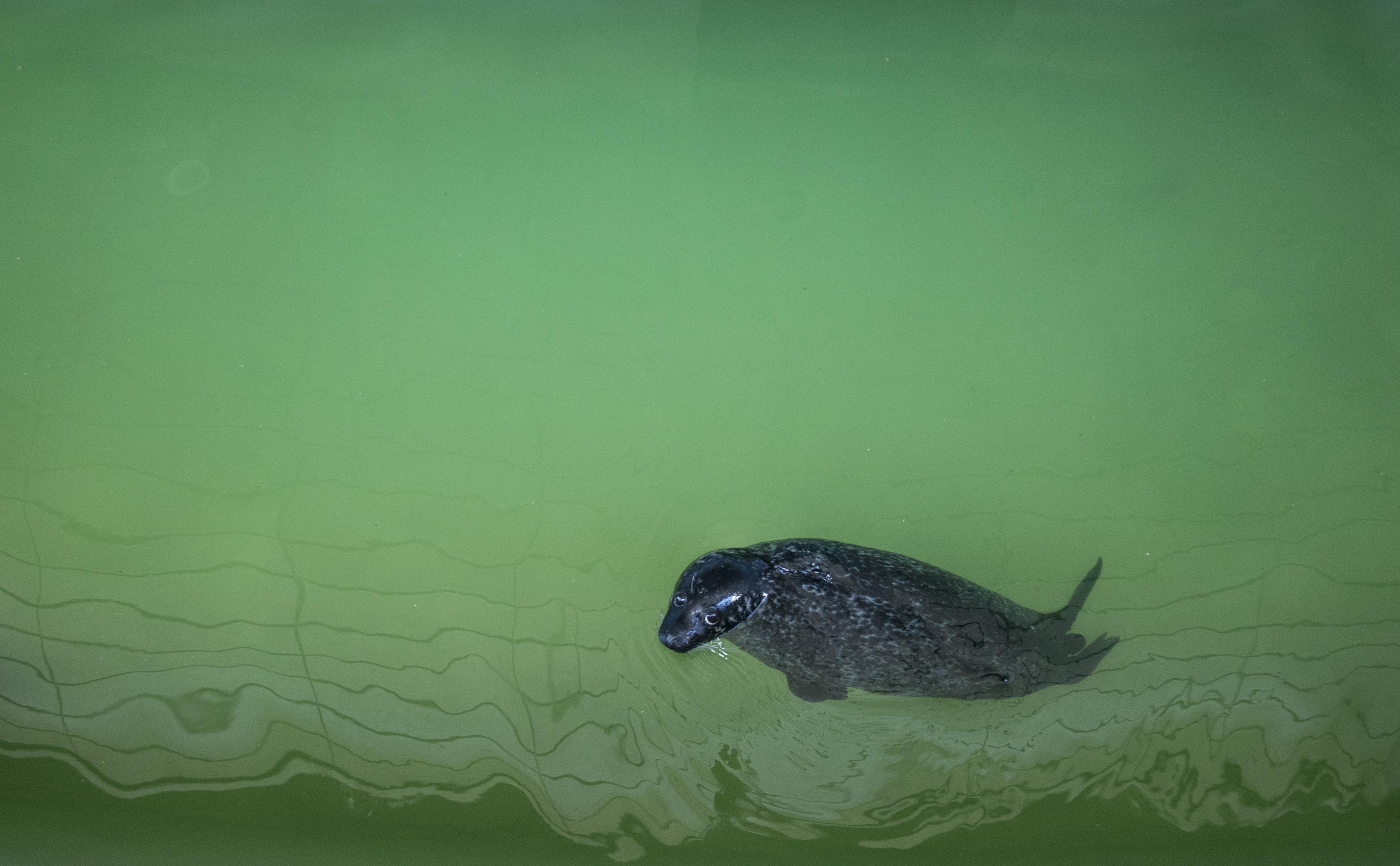Due to the young geological age of the Baltic Sea, no endemic animal species have emerged here
The Baltic Sea mixes typical freshwater and marine conditions, so there are organisms of both marine and freshwater origin. Due to these special conditions, the number of species in the Baltic Sea is lower than in a sea with typical salinity. Many of the species here live under constant stress caused by salinity and temperature, which makes them highly sensitive to changes in the environment, especially anthropogenic changes. The abundance and growth rate of marine species in the Baltic Sea are mostly correlated with salinity – more species are found in the southern region with higher salinity [1]. The poorest areas are the depths of the central part of the Baltic Sea. There is no definite pattern in species abundance in the eastern part.

SPECIES RICHNESS IN THE BALTIC SEA. Source: HELCOM Checklist 2.0 of Baltic Sea Macrospecies
The vegetation of the Baltic Sea
The vegetation in the Baltic Sea is poor in species, but quite rich in specimens. Its main component is algae. There are more than 3,000 species of microalgae, or phytoplankton, the most important of which are diatoms, blue-green algae, and Conferva. More than 450 species of macroalgae have been found, the most numerous being red and brown algae [2]. There are less than 100 species of flowering plants, including, for example, the pond water-crowfoot, Ranunculus circinatus, hornwort, Eurasian watermilfoil, sago pondweed, and eelgrass. Approximately 1,200 species of microalgae and 60 taxa of macrophytes (including 12 species of flowering plants) occur in the Estonian coastal sea [3; 4].
The fauna of the Baltic Sea
The fauna of the Baltic Sea is made up of organisms that remained here during the different periods of the formation of the sea: brackish and marine glacial relics (descendants of species who migrated to the Yoldia Sea), marine boreal species, and freshwater species from continental waters. Due to the young geological age of the Baltic Sea, endemic animal species have not emerged here [5].
More than 2,000 species of invertebrates live in the Baltic Sea [1]. Of these, true jellyfishes, comb jellies, mud dragons, priapulid worms, and bristle worms are pure marine species. Other groups are either brackish or freshwater species, who also tolerate lower salinity [5]. Of zooplankton, Estonian waters are dominated by marine and brackish copepods, and in summer by water fleas and rotifers. Benthic fauna is represented in the Estonian sea area by 92 taxa [4]. Among the mussels, the blue mussel, Baltic clam, soft-shell clam, bay mussel, and zebra mussel live in Estonian waters.
There are 242 fish species in the Baltic Sea [1]. Due to the low salinity of the Baltic Sea, many freshwater fish species live here, but there are also species from the Atlantic Ocean. Ocean fish in the Baltic Sea are often smaller than their counterparts in the oceans, and some of them do not have offspring here due to the low salinity of the sea. In addition, there are migratory fish in the Baltic Sea that migrate from the sea to spawn in freshwater or vice versa [6]. The most common and numerous fish species in the Baltic Sea are the sprat, Baltic herring, flounder, and cod, which are also important fish for catching [7]. The sprat and Baltic herring account for more than 90% of Estonia’s commercial catches. However, salmon, perch, zander, and flounder are important in Estonia for small-scale/local coastal fishing [6]. There are 32 species of marine fish, 10 species of migratory fish, and 26 species of freshwater fish living in the Baltic Sea in Estonian territories [8].
Many bird species are connected to the sea. 159 waterbird species nest or winter near the Baltic Sea [1]. Among the nesting birds, large numbers of shorebirds (e.g. ruff, gulls, Sterna, Eurasian oystercatcher) and waterfowl (e.g. geese, ducks, and swans) are represented. The most numerous migratory species are the long-tailed duck, eider, tufted duck, scoter, and mallard.
There are four species of mammals in the Baltic Sea: the grey seal, the ringed seal, and the harbour seal of seals, and the harbour porpoise of cetaceans [1]. Other cetaceans (bottlenose dolphin, humpback whale, Beluga whale, and white-beaked dolphin) also sometimes accidentally end up here.

Last modified: 15.11.2021
__________________________________________________
[1] J. Wolf. HELCOM Checklist 2.0 of Baltic Sea Macrospecies. Baltic Sea Environment Proceedings no 174. 2020.
https://helcom.fi/wp-content/uploads/2020/12/BSEP174.pdf
[2] Läänemere taimestik. Wikipedia. 2019.
https://et.wikipedia.org/wiki/L%C3%A4%C3%A4nemere_taimestik
[3] T. Trei, A. Jaanus, H. Kukk, J. Paal. Läänemere taimestik. Eesti Entsüklopeedia, 2002; 2011.
http://entsyklopeedia.ee/artikkel/l%C3%A4%C3%A4nemere_taimestik
[4] K. Torn, G. Martin. Eesti mereala makrofüütide ja suurselgrootute liiginimekirjade koostamine. Aruanne, 2018.
https://kese.envir.ee/kese/downloadReportFile.action?fileUid=12946450&monitoringWorkUid=12946300
[5] R. Aps, M. Kangur, E. Ojaveer, T. Saat. Läänemere loomastik. Eesti Entsüklopeedia, 2002; 2011.
http://entsyklopeedia.ee/artikkel/l%C3%A4%C3%A4nemere_loomastik
[6] A. Lotman, G. Martin, K. Viik, U. Lips (toim). Eesti mereala keskkonnaseosund 2018. Tallinn: Keskkonnaministeerium.
[7] Läänemere elustik. Eesti Merebioloogia Ühing.
http://www.merebioloogia.ee/laanemere-elustik-2/
[8] Eesti merekalad. Eesti entsüklopeedia, 2002; 2011.
http://entsyklopeedia.ee/artikkel/eesti_merekalad